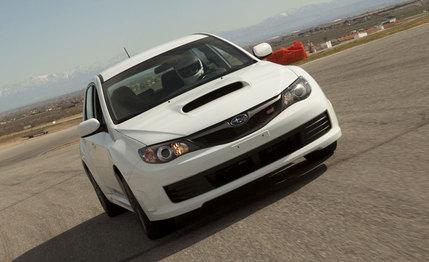
 First Drive Review
First Drive Review
If you know what the acronym JDM stands for—“Japanese domestic market”—and that it doesn’t refer to cleaning products for Tokyo housewives, then the 2010 Subaru Impreza WRX STI Special Edition will probably interest you.


The Special Edition is the rabid all-wheel-drive proto-rally STI we all know, but Subaru incorporates the suspension tune from the Japan-only STI spec C to make it firmer, less prone to understeer in corners, and a generally sharper sword on pavement. Subaru also pulls out some of the luxury content of the regular STI and cuts the price by $2000, to $33,690. Subaru will build just 500 for the U.S.—and only in 2010—the first 125 in exclusive Aspen White, the rest in black, blue, or dark gray metallic. After that, the SE will be KO’ed, no doubt replaced by another one-year special.
Small Changes Add Up
The spec C’s suspension tweaks are all pretty minor. The front springs are 16 percent stiffer, the rears 29 percent stiffer. Firmer rear subframe bushings prevent cornering loads from twisting and thus altering the rear geometry, although at the cost of ride isolation. The car sits a fine hair (0.04 inch) lower and has a slightly thicker rear anti-roll bar.
We’ve sampled the result at the snaking 1.8-mile Streets of Willow Springs racetrack in California’s high desert north of Los Angeles and found that the suspension tweaks do indeed give the STI SE greater steering response on the Streets’ tight corners. This is a more trackable STI than the regular model, which also has 305 hp and the same driver-tunable all-wheel-drive system but suffers from tire-torturing plow in corners. Legions of STI owners have upgraded their cars’ suspension on their own to try to make them turn more eagerly, and now Subaru is doing it for you while cutting the car’s price. What’s not to like?
What You’re Missing
Comfort items pulled out include the upgraded stereo with its six-CD changer (replaced by a single-CD, four-speaker setup), xenon headlamps, and automatic climate control. The spec C’s charcoal-colored 18-inch, 14-spoke aluminum rims wearing 245/40 Dunlop SP Sport 600s look particularly fetching on the Aspen White car.
However, the SE doesn’t get the full spec C treatment, as installing the spec C’s lightweight buckets, thinner glass, and modified turbo would have cost Subaru a new, very expensive federal-regulation compliance ticket.
Hard-core JDMers might have been disgusted, but when it was relaunched in 2008, the STI was made generally more relaxed, comfortable, and every-day livable with a softer ride and longer roster of amenities. It was a nod to those who can actually afford a $35,690 STI, not those who so desperately want one that they paper their school lockers with pictures of them.
But Subaru aims to please, so the SE circles back to those who can both afford an STI and want one that’s a bit harder at the core. Subaru believes those inclined to give their cars over to tuners will especially want the SE as a starting point. Plus, the SE makes a better case for the STI in the face of the newly butched-up, STI-aping 2011 WRX.
Driving the SE is the same gas-on/brake-on/gas-on driving experience as in the standard STI. You use the thick torque of the 2.5-liter turbocharged boxer-four to storm up to a corner. You then stand on the brakes while turning, letting the momentum help bring the rear around. Then you stand on the gas to send torque to the rear axle, thus helping turn the car even more. The difference in the SE is that it all works better, the nose aiming for the apex with a stronger response to your steering input than in the regular STI. The SE is no more prone to drifting oversteer—the all-wheel-drive system with its electronic center differential remains unchanged—but in the SE you don’t need as much push from the back. The car changes direction with more enthusiasm and stays flatter and better grounded in fast transitions.
This is no miracle. It’s just a somewhat subtle improvement by degrees. Within a few laps, the stock tires are too hot for anything but silly sliding around. But the SE, like the STI, is a ton (actually, 1.7 tons) of fun, and well worth the money, especially considering that it’s cheaper.